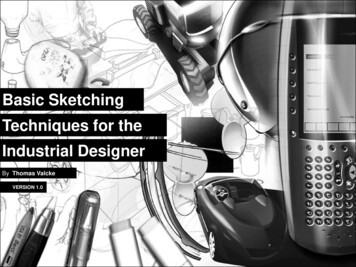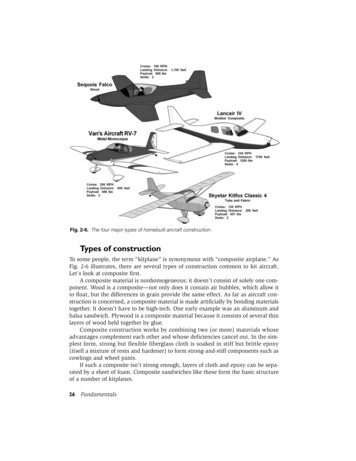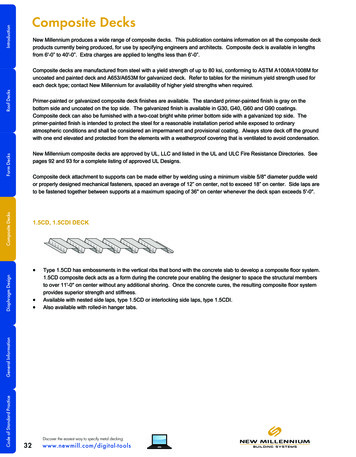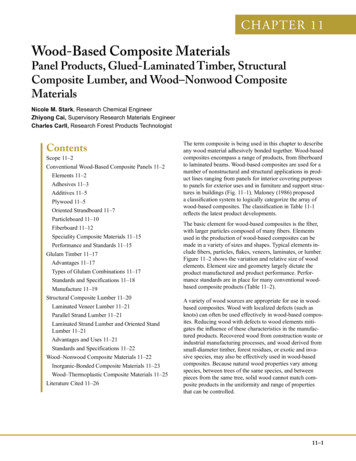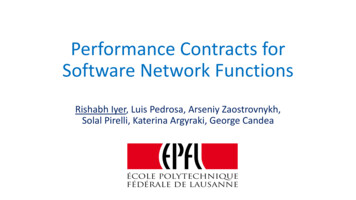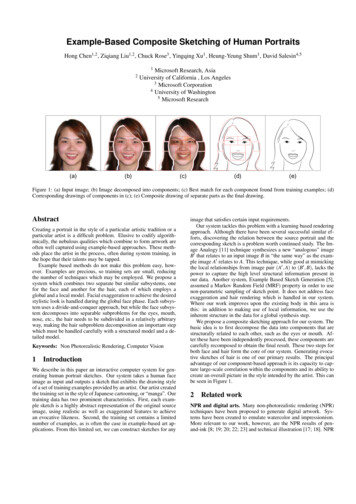
Transcription
Example-Based Composite Sketching of Human PortraitsHong Chen1,2 , Ziqiang Liu1,2 , Chuck Rose3 , Yingqing Xu1 , Heung-Yeung Shum1 , David Salesin4,512(a)Microsoft Research, AsiaUniversity of California , Los Angeles3 Microsoft Corporation4 University of Washington5 Microsoft Research(b)(c)(d)(e)Figure 1: (a) Input image; (b) Image decomposed into components; (c) Best match for each component found from training examples; (d)Corresponding drawings of components in (c); (e) Composite drawing of separate parts as the final drawing.AbstractCreating a portrait in the style of a particular artistic tradition or aparticular artist is a difficult problem. Elusive to codify algorithmically, the nebulous qualities which combine to form artwork areoften well captured using example-based approaches. These methods place the artist in the process, often during system training, inthe hope that their talents may be tapped.Example based methods do not make this problem easy, however. Examples are precious, so training sets are small, reducingthe number of techniques which may be employed. We propose asystem which combines two separate but similar subsystems, onefor the face and another for the hair, each of which employs aglobal and a local model. Facial exaggeration to achieve the desiredstylistic look is handled during the global face phase. Each subsystem uses a divide-and-conquer approach, but while the face subsystem decomposes into separable subproblems for the eyes, mouth,nose, etc., the hair needs to be subdivided in a relatively arbitraryway, making the hair subproblem decomposition an important stepwhich must be handled carefully with a structured model and a detailed model.Keywords: Non Photorealistic Rendering, Computer Vision1IntroductionWe describe in this paper an interactive computer system for generating human portrait sketches. Our system takes a human faceimage as input and outputs a sketch that exhibits the drawing styleof a set of training examples provided by an artist. Our artist createdthe training set in the style of Japanese cartooning, or “manga”. Ourtraining data has two prominent characteristics. First, each example sketch is a highly abstract representation of the original sourceimage, using realistic as well as exaggerated features to achievean evocative likeness. Second, the training set contains a limitednumber of examples, as is often the case in example-based art applications. From this limited set, we can construct sketches for anyimage that satisfies certain input requirements.Our system tackles this problem with a learning based renderingapproach. Although there have been several successful similar efforts, discovering the relation between the source portrait and thecorresponding sketch is a problem worth continued study. The Image Analogy [11] technique synthesizes a new “analogous” imageB that relates to an input image B in “the same way” as the example image A relates to A. This technique, while good at mimickingthe local relationships from image pair (A , A) to (B , B), lacks thepower to capture the high level structural information present inour data. Another system, Example Based Sketch Generation [5],assumed a Markov Random Field (MRF) property in order to usenon-parametric sampling of sketch point. It does not address faceexaggeration and hair rendering which is handled in our system.Where our work improves upon the existing body in this area isthis: in addition to making use of local information, we use theinherent structure in the data for a global synthesis step.We propose a composite sketching approach for our system. Thebasic idea is to first decompose the data into components that arestructurally related to each other, such as the eyes or mouth. After these have been independently processed, these components arecarefully recomposed to obtain the final result. These two steps forboth face and hair form the core of our system. Generating evocative sketches of hair is one of our primary results. The principaladvantage of our component-based approach is its capacity to capture large-scale correlation within the components and its ability tocreate an overall picture in the style intended by the artist. This canbe seen in Figure 1.2Related workNPR and digital arts. Many non-photorealistic rendering (NPR)techniques have been proposed to generate digital artwork. Systems have been created to emulate watercolor and impressionism.More relevant to our work, however, are the NPR results of penand-ink [8; 19; 20; 22; 23] and technical illustration [17; 18]. NPR
techniques have also been used to depict facial images with an artistic style. Examples include digital facial engraving [15] and caricature generation [3]. However, most of these are concerned with emulating traditional artist tools to assist users in drawing pictures witha certain style. There are rare attempts to generate digital paintingsby learning from artists.Modeling and rendering hairs. Hair is an integral part of aperson’s appearance. A portrait does not look natural without arealistic-looking hair style. To date, hair rendering remains one ofthe most difficult graphics problems, although much progress hasbeen made on photo-realistic hair rendering [12]. Most of the workin this area is based on 3D hair model editing and rendering. Recentwork by Grabli et al. [10] attempts to automatically reconstruct ahair model from photographs. Little work has been done on nonphoto realistic hair rendering from an input image, which is thefocus of this paper, especially in an stylized way.Example-based learning and synthesis. Recently, a number ofexample-based approaches have been proposed for texture synthesis and image synthesis including image analogies by Hertzmann etal. [11], face hallucination by Baker and Kanade [2], and learningusing low-level vision [9]. The basic idea is to analyze the statisticalrelationship between the input and output images, and model the details of the artist’s style with the learned statistical model rather thanwith hand-crafted rules. Indeed, it is natural to specify artistic stylesby showing a set of examples. Chen et al. [5], for instance, developed an example-based facial sketch generating system. Using inhomogeneous non-parametric sampling, they were able to capturethe statistical likelihood between the sketch and the original image,which allowed them to fit a flexible template to generate the sketch.However, this method is limited to generating sketches with stifflines. Chen et al. [4] recently improved their system by combiningfeatures in both sources and drawings.3System FrameworkOur goal when we designed our algorithms was to create a systemthat could leverage the artist’s skill with a high degree of automation after an initial training phase. Our artist created a training setdesigned to span the gamut of east Asian female faces. Based inpart on our artist’s knowledge, we divided our portrait system intoa face subsystem and a hair subsystem.The face subsystem divides the problem into meaningful components, by segmenting the problem into subproblems for each of thenatural facial features, i.e. eyes, mouth, hair. A component-levelmodel handles the overall arrangement, and a local model adjuststhis initial result. The hair subsystem, on the other hand, segmentsthe problem in a more-or-less arbitrary way, based on an insight ofour artist. These subproblems are tackled independently, but caremust then be taken when reassembling the hair so as to create a uniform whole. The face subsystem is covered in the next section, andthe hair subsystem in Section 5.4Composing a FaceSuppose {(Ii , Ii ), i 1 : n} is the training set, where each Ii is a colorface image and Ii the corresponding sketch drawn by the artist. Ourobjective is to construct a modelp(I I, (Ii , Ii ), i 1 : n)(1)to take an input image I and generate a sketch I that matches thestyle of the training examples.We split the model into two layers, global and local. The globallayer aims to capture how the artist places each face element in thesketch image. The local layer tries to mimic how the artist drawseach independent element locally. More formally, we have assumedFigure 2: The framework of face subsystem.the following gp(I I, (Ii , Ii )) p(I l I l , (Ii l , Iil ))p(I g I g , (Ii , Ii )),g(2)which indicates that the global and local styles of a drawing areindependent and their models could be constructed separately.The overall steps of the face subsystem are shown in Figure 2.In the training phase, we decompose the training example into a g ggglobal set {Ii , Ii } and a local set {Ii l , Ii }. In the synthesis phase,each input image is first split into a global feature vector I g and a g glocal feature vector I l . Then we explore the global set {Ii , Ii } togg find for I a good match I in the sketch space. In the same way, thematch for I l can be found as I l . Finally, I g and I l are recomposedto form the final result.4.1Drawing the facial component with the local modelIn practice, a human face is decomposed semantically into 6 localcomponents, one for each of the major facial elements, of 4 types.They are left & right eyebrows, left & right eyes, a nose, and amouth. Each type of feature is further divided into several prototypes based on their appearance in the training data.As shown in Figure 4, the eyebrow component has two prototypes which are classified as thick and thin. The eye component has11 prototypes which could be roughly clustered into 2 classes, thosewith or without a contour above the eye and below the eyebrow. Thenose component has 3 prototypes and the mouth component has 4.For each new component, we extract the accurate shape and associated texture information using a refined Active Shape Model(ASM) [7]. Then we determine to which prototype the componentbelongs and its associated warping parameters. We build a differentclassifier for each type of component and use these to cluster the input components into the appropriate prototype. k-Nearest Neighbor(kNN) interpolation is then used within the prototype set to calculate warping parameters. With prototype information and warpingparameters, we are able to draw the face element locally.4.2Composing the face using the global modelCaptured implicitly in the global model is the style which the artistuses to arrange each face element on a canvas. Most artists employ a semi-regular formula for drawing facial caricatures. Theyuse a standard face as a frame of reference for determining how toexaggerate a subject’s features. The two critical guides are the relationship of elements to others of their own kind and the relationshipof elements to their surrounding and adjacent elements.
ww2w1(a)(b)w3(c)w4Figure 3: The effect of the local and global model. (a) The inputimage; (b) Sketch created with local model; (c) Sketch after globalmodel incorporated.e1e2e3e4w1hh1w5w6w7h4h4h4h2h3Figure 5: 14 features defined for a global model.(1)(2)(3)(4)Figure 4: The prototypes extracted from the training set.For the representation of I g , we carefully chose 14 features froma pool of approximately 30 recommended facial features in a caricature drawing textbook [16]. They arew1 /wh1 /hw2 /wh2 /hw3 /wh3 /hw4 /we1w5 /we2w6 /we3w7 /w.e45.1(3)These relations describe the proportion of the face devoted to a particular facial feature. w4 /w, for instance, relates the width of thehead to the width of the mouth. By not tying these relations to fixedvalues, the model can adjust the size of the features as the overallsize of the head is changed. For any input face image I, we firstuse an Active Appearance Model (AAM) [6] to determine the 87control points. We then use these control points to generate I g . Todetermine the placement of these face elements on the cartoon canvas, each element needs five parameters {(tx ,ty ), (sx , sy ), θ }. (tx ,ty )represents the translation of the element in the x and y directionsrespectively. (sx , sy ) are the scaling parameters and θ is the relative rotation angle. Additionally, the face contour needs the warpparameter cw . Together, these constitute I g . As shown in Figure 3,while each of the facial features drawn using the local model arecorrect, their overall composition is lacking. The global model improves the sketch, making a more vivid overall face.Learning the relation between I g and I g from a set of examplesis non-trivial. Instead of simple linear mapping, we use k-NN interpolation to reproduce this non-linear mapping. We also makeuse of heuristic methods adopted by the artist. A previous systemby Liang et al. [14] used partial least squares to learn facial features automatically. Since the number of examples is usually verylimited and hand-annotating each example is a relatively minor additional cost over their initial creation, we believe our method ismore appropriate and robust.5challenging. Even if we decompose the hair into regions, recomposition remains a difficult step. Finally, there is no clear correspondence between regions of two different hairstyles. Lacking acorrespondence, we cannot use blending techniques.Due to these factors, we synthesize the hair independently fromthe face, employing a different mechanism. The overall flow of ourhair system is shown in Figure 7. First the image is dissected into 5regions we call the structural components. Our subject’s structuralcomponents are matched against the database and the best matchis selected for each. The n-best matches can be chosen to createa range of pictures for the user. These matched components arewarped and assembled into an overall model for the hair. To this,details are added based upon the subject image. This process isdetailed in the remainder of the section.Composing hairHair cannot be handled in the same way as the face. This is due toa number of reasons. First, hair has many styles and is not structured in the same regular way that faces are, so building a modelis not straightforward. The hair is in many ways a single unit, often rendered using long strokes, making meaningful decompositionHair composite modelTwo key aspects make it possible to render the hair. Critically, theglobal hair structure or impression is more important than the details, especially for a highly-stylized look like manga. Attention tobasic detail is not necessary since a person’s hair details are rarelystatic. Wind, rain, rushed morning preparations, or severe sleepdeprivation brought on by Siggraph deadlines, can all affect the details of one’s hair. Figure 6 shows the three best results for a singlesubject’s hair. All exhibit the correct shape, and picking betweenthem can be at the behest of the user or chosen automatically by thesystem.As suggested by our artist, we coarsely segment the hair into fivesegments, as shown in Figure 7. Each is in a fixed position and maydivide long strokes that are fixed later on. We chose these segmentsbecause each indicates important global information about the hair,so we name these our “structural components”. In addition to thestructural (global) model, we also use a detail model. Artists oftenuse detail to add uniqueness and expression to a portrait. Thesedetails confuse the global model, but we take them into accountwith a detail model, the final phase in our hair sketch synthesis.5.2Extracting the image features for the hairWhen an input image is presented to the system we first performan image processing step. We use this step to determine the imagefeatures of the hair which we can then match against the database.The two techniques we employ are an estimated alpha mask andhair strand orientation fields, as shown in Figure 8.First, an alpha mask is calculated to separate the hair region frombackground and face. A pixel used for hair can often be blendedwith those used for the background and face, which is why an alphamask is needed, rather than a simple bit mask. Knockout [1] is usedto generate the mask, as shown in Figure 8(a).Hair orientation is a very useful feature for determining theplacement of strokes. We begin by using steerable filters to calculate the orientation of each pixel in the hair as demarcated by the
Structural ComponentsTraining ExamplesDetail Components Figure 7: Hair System Flow(a)(a)(b)(b)(c)Figure 8: For the input image from Figure 7: (a) Estimated alphamask; (b) User defined hair growing region on a smoothed edgefield by red brushes; (c) Estimated hair growing field.StructuralComponentStyles(c)Figure 6: (a) An input image; (b)(c)(d)Three results for the inputimage. They all have the correct structural information.alpha mask. Weighted smoothness is then used to propagate orientation information from high strength regions to regions whichare weak, in order to stifle noise in the original orientation field.These automatic orientation calculations alone cannot yield an accurate picture of what the hair is like. Some information, such aswhere the hair grows from is not easily calculated, so we require theuser to annotate the input image to indicate hair growth (part). Thisis done with a simple brush stroke, as shown in Figure 8(b). Thegrowth direction from this region can be calculated as the hair tendsto grow away from the growth region, the information propagatedoutward subject to a smoothness constraint using belief propagation [21]. The final result is shown in Figure 8(c).5.3Examples(d)Fitting structural componentsFor an input hair component H, we seek to find the most similarexample in the training set. For effective matching, all the examplesFigure 9: Structural Components of hair.are clustered into several styles, each of which has a roughly similarlook and coarse geometric correspondence. This correspondence isdetermined by a set of key points, which are indicated manually inthe training data, as shown in Figure 9. For an input image, findingthe best training example to use is divided into two steps: first weclassify H into the correct style and then we find the best trainingexample in that style to match H.As previously mentioned, hair components of the same styleshare a set of corresponding key points, which we denote as theshape S [x1 , y1 , .xm , ym ], where m is the number of key points.Then, we can deform hair components with the same style to a samestandard shape using a multi-level freeform deformation warpingalgorithm [13]. The mean shape of training examples is chosen asthe standard shape for each style.After deforming hair to the same shape, we choose the hairorientation vector and alpha value of each pixel as the appear-
(a)(a)(b)(c)(b)(c)Figure 11: Three patterns of the boundary and their image features.The yellow block is the local coordinates along the boundary.Figure 10: Detail components of the hair are divided into boundarydetails and bang details.ance features of the hair. We denote the hair orientation vector as G [gx1 , gy1 , gx2 , gy2 , .gxn , gyn ] and the alpha value asα [α1 , α2 , .αn ], where n is the number of pixels in the component region. Because bangs and hair tails have toothed shapes andthe primary characteristics for these hair features is their length andthe average density along their orientation path, we use an ellipticGaussian kernel to smooth the alpha values.Given all this, for two hair components with the same style, wecan define the distance function of the their appearances as:E(H1 , H2 ) G1 G2 w α1 α2 (5)where ωi is a constant weight for each style, such that the mean ofthe Ei (H) for the example hair components equal to 1.After we determine the style of the input hair H and fit the keypoints S, we find the best matched training example by minimizingthe distance combining the shape and appearance features:min E(H, H j ) γ S S j j(6)where H j is the jth example in the particular style, γ is a weight tobalance the effect of the shape distance and appearance distance.5.4(b)(c)(d)Figure 12: Fitting the bang detail components. (a) Input hair withstructure spline; (b) Within the boundary of the hair in green, wetrace the orientation field starting from the yellow line; (c) Thelength of the traced streamline along the boundary; (d) The blueline is the traced bang skeleton.(4)where w is a weight.For the ith style, with the labelled key points for each example,we get the appearance features of each example and average them toget the mean appearance H̄i . And we can fit the key points of hair Hin the ith style by minimizing E(H, H̄i ) using an active appearancealgorithm [6].Also we can define the distance between hair H and the ith style,and determine the best style of the hair by minimizing it:Ei (H) ωi · E(H, H̄i ),(a)Fitting detail componentsIn addition to finding the best structural components, we also needto determine the detail information present in the input image. Different kinds of detail require slightly different approaches. We define two classes of detail, “boundary” and “bang” detail, as shownin Figure 10. Boundary details are typified by wispy strands of hairparallel to the main region of hair. Bangs are strands of hair whichfall away from the bulk of the hair onto the face.Boundary details fall into three categories, as shown in Figure 11. The alpha values and orientations for these patterns arequite different, so we can use a small window to enable classification of each point, providing a way to sort the boundary details intotheir appropriate categories. We summarize this information forthe boundary details in the training samples, estimating a Gaussiandistribution for each kind of pattern.Bang detail components are used to detect the bang, such as inFigure 12(a). The first step to finding bangs uses a low thresholdto segment out the bang regions in the alpha mask, indicated bythe green boundary in Figure 12(b). The orientation field can beinspected in this region to find bangs, using a threshold to weedout bangs of trivial length, where this threshold is indicated by theyellow line. Next, we determine the length of the bang line, asshown in Figure 12(c). Connecting this with the smoothed banggives us our detail bang component, as shown in Figure 12(d).5.5Synthesizing the hair sketchThe strokes in the training samples are all divided into two classesin the training phase: boundary strokes and streamline strokes. Wedefine the points in the strokes crossing the boundary of a structuralcomponent to be “link points”.Face contour exaggeration requires that we adjust the lower partof the inner hair boundary using the corresponding face contour.Then the strokes of the matched structural components are warpedto the target coordinates using corresponding boundaries as shownin Figure 13(a). Matching the link points in different structuralcomponents must ensure that the link points match to those in thesame class (boundary to boundary, streamline to streamline), andthat the matching distance is minimized. This can be handled usingbipartite graph matching, as shown in Figure 13(b).For each matched pair of link points, we adjust them to the average position and link the corresponding strokes, smoothing alongthe stroke and varying the width and style to make the drawing moreexpressive. We consider the styles of the two linked strokes, adjusting to get a good match, as shown in Figure 13(c). Unmatchedstreamline strokes are removed if they are too short, otherwise theyare extended, tapering the end to trail off their effect on the image.Final results are shown in Figure 13(d).Detail components are connected to strokes generated by thecomponent match. In the training data, details are connected to
(a)(b)(c)(d)Figure 13: Composing the structural components. (a) Warp strokes of matched structural components to target image. The red line is theboundary between different components; (b) Find a match for each link point. The red round point is the link point of the boundary strokeand the green rectangle point is that of the streamline stroke. The red circle shows the match. (c) Link and smooth matched stroke. Forunmatched link point of streamline, detection of too short strokes which is shown in the green circle, other link points shown in the red circleshould be extended. (d) Remove short strokes and adjust the streamline to get the final result.(a)(b)(a)(b)(c)(d)(e)(f)(c)Figure 14: Add the detail strokes. (a) Strokes of the detail component with ”link point”; (b) Warp strokes from local coordinatesto the target coordinates; (c) Link detail strokes to the referencestroke.reference strokes. These link points are used in a similar way tothe link points in the global phase, such as in Figure 14(a). First,the stroke of the matched detail is warped to the target coordinatesfrom the global phase, as shown in Figure 14(b). Reference strokesare cut and the detail is inserted, smoothing any discontinuities inthe linkage. This gives us our final result, as shown in Figure 14(c).Figure 15: Results of face part.(a) The original face image; (b) Theresult of local model; (c) The result of local model plus globalmodel; (d) Result without local model and global model. (e)(f)Results with user selected local prototypes.6all of the strokes and get the result in Figure 16(d). It has the samestructural information as the previous result; however, it does notmatch the details of the input image absolutely.Also, the user can generate the result interactively. But the goalof our system is to draw the hair from the input image. So, for eachcomponent, we show the n-best match examples, and the user needonly click the mouse and select one of them. The user can alsoremove detail components if they prefer an abstract one. The resultof different choices is shown in Figure 16(e-f).Combining the face and the hair, we need to remove the boundary strokes of the hair that overlap the face contour. In Figure 18,we show some results generated by our system. Neck, shoulder, andclothing are chosen from a set of templates supplied by our artist.52 separate training examples were used for this system.ExamplesAs shown in Figure 15, for an input image (Figure 15(a)), we decompose it into parts. For each part, we classify it into one prototype and draw it using the examples (Figure 15(b)). Then weexaggerate it using the global model and get the final result in Figure 15(c). We can see that the final result of our system is locallysimilar to the previous one, but the size of the mouth and the shapeof the contour are notably different to make it more “manga”. Incomparison, we show the sketch result without local model variation or a global model in Figure 15(d), which is similar to the resultin [5]. Our result is obviously more expressive.Users may prefer a particular prototype of the local componentor the exaggeration effect. Our system allows the user to changethe result interactively to find the result with the best style as inFigure 15(e-f).For the hair of the input image in Figure 16(a), we decomposeit into structural components and detail components. The result ofcomposing structural components captures the global style of thehair as in Figure 16(b). And then we add unique detail to make itmore expressive as in Figure 16(c). With the two level componentsmodel, we can obtain better results especially with a small set ofexamples. In comparison, we let the structural components contain7DiscussionWe believe that adapting a global/local hybrid was an effective approach for generating face portrait sketches. The face, being morestructured than the hair, was a clear fit for this approach, but thehair worked exceptionally well once a recomposition fixing stagewas added. Systems like this have many applications, such as creating virtual personas for cartoon style online games or chat environ-
Figure 17: Two examples of the Manga style training data in our system. We use 52 in the working system.(a)(b)(c)(d)(e)(f)Figure 16: Compare the effect of adding detail strokes. (a) Theoriginal image; (b) Result of composing structural components; (c)Composing with detail components; (d) Result of one level modelwhere all of the details strokes remain in structural components.(e)(f) Composed hair by user selected components.ments. Obvious extensions would be to use this system to automatically create sketched portraits for places where a sketch is preferredover a photograph, such as on the cover of The Wall Street Journalprovided that an appropriately styled training set is used. Allowingpeople to explore a change of look is another application.Our system has some limitations we hope to address in futurework. We obviously want to add to our training set so we can encompass faces of many racial backgrounds. Our use of white background portraits was a very good fit for the relatively pale skin ofeast Asian females and may work well for Caucasian races, but maybe a poor fit for people whose ancestors are from southern Asia,Africa, and Polynesia, for example. Vastly different hair styles,such as dread locks or a mohawk may not fit well into our framework at present. Clearly, we also want to render male images aswell, which presents the additional challenge of facial hair, blurringthe line between the facial and hair subsystems. A third subsystemto handle facial hair, which is different in many ways from scalphair, may be in order. Aging, injury, spectacles, and jewelry, are allobvious extensions.References[1] A.Berman, A.Dadourian, and P.Vlahos. Method for removing from an imagethe background surrounding a selected object. U.S. Patent 6,134,346, 2000.[2] S. Baker and T. Kanade. Hallucinating faces. In AFGR00, 2000.[3] S. Brennan. The caricature generator, 1985.[4] H. Chen, L. Liang, Y.Q. Xu, H.Y. Shum, and N.N. Zheng. Example-basedautomatic portraiture. In ACCV02, 2002.[5] H. Chen, Y.Q. Xu, H.Y. Shum, S.C. Zhu, and N.N. Zheng. Example-basedfacial sketch generation with non-parametric sampling. In ICCV01, pages II:433–438, 2001.[6] T. Cootes and C. Taylor. Statistical models of appearanc
Example-Based Composite Sketching of Human Portraits Hong Chen1,2, Ziqiang Liu1,2, Chuck Rose3, Yingqing Xu1, Heung-Yeung Shum1, David Salesin4,5 1 Microsoft Research, Asia 2 University of California , Los Angeles 3 Microsoft Corporation 4 University of Washington 5 Microsoft Research (a) (b) (c) (d) (

